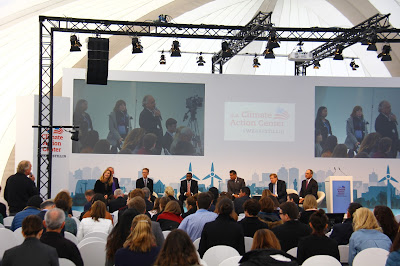Cindy Isenhour
As a first-timer to the COP, it is certainly easy to see how the process can be tiring - and particularly for representatives from nations with small delegations that simply can't be everywhere at once. There are often multiple negotiations happening in parallel, not to mention the other side events, pavilion events, demonstrations and the basic necessities (like eating - I've seen many delegates rushing through the halls from session to session with a croissant in hand). Today, in the spirit of solidarity and, generally, exhaustion - I offer a photo blog of my day. I'll get back to substance tomorrow!
 |
| 9:00 Research and Independent Non-Governmental Organization (RINGO) daily meeting. UMaine representatives Aaron Strong and Anna McGinn listen intently for opportunities to represent the group at closed negotiation sessions. |
 |
| 10.00 - 12.00 After nearly an hour of deadlock on the informal note presented by the facilitators, the meeting of the Subsidiary Body on Scientific and Technical Advice for Paris article 6 (on global carbon mechanisms to enhance mitigation and sustainable development), Parties are encouraged to"huddle" to work out differences on the wording of paragraph four. Note this initial picture shows two huddles. After an intervention by the facilitators they moved together, but no consensus emerged before I had to leave for a closed session (to which I had a pass). |
 |
| 12:00 - 13.00 The Ad Hoc Working Group on the Paris Agreement, Article 14 (the Global Stocktake, designed to provide a means to measure global progress every five years) moves to huddle before their session even begins. Without facilitation and with strong leadership and flexibility, they are able to reach an agreement to move forward (noting areas of divergence), and the meeting ends early. |
 |
| 13.00 - 14.10 Moving back now to the SBSTA meeting on Article 6 (carbon trade/non-market mechanisms), the huddle had shifted in form several times but no agreement had been reached. Here the EU delegate is pointing to the screen to suggest specific changes. Divergent opinions held - but, several more informal huddles and interpersonal party-party negotiations later, the facilitators announced a breakthrough. They gave the floor to the EU which reported the Parties were not quite ready. The meeting was adjourned until 3pm. |
 |
| 14.15 In need of a break I took one of the conference bikes for a spin and got a chance to check out some of the exhibits and demonstrations between the Bula (official negotiations) and Bon (civil society) areas of the campus. Lady Liberty's torch emits smoke (not a good pic here). |
 |
| 14.30 The InsuResilience Announcement |
 |
| 14.45 Pretending that the meetings (hosted by Fiji but in Germany) were really in Fiji! |
 |
| 14:50 Caught an informal conversation between David Banks (US Energy Advisor and the previous night's presenter of fossil fuel-based climate mitigation strategies - received by significant public demonstrations) and a representative of African group interests. The conversation seemed productive and quite civil until they were thronged by media, only a few minutes later. |
 |
| 15.00 - 16.00 Returning to the meeting of the SBSTA group on Article 6 (market and non-market carbon mechanisms to enhance mitigation and contribute to sustainable development), I was surprised to see they still were not ready to announce their breakthrough. After considerable discussion, the text required to carry the process forward into the next SBSTA meeting in May was approved. Unfortunately substantial matters about the mechanisms were left for future discussions. |
 |
16.00 - 18.00 Ad Hoc Working Group on the Paris Agreement takes stock of the progress made on all agenda items. There was significant discussion of the text before the co-chairs decided to take a break to reconsider the text and possible revisions that could recognize all the concerns voiced.
18.00 - 20.00 Higher Education reception at the We' Are Still In Pavillion (pictures to come) |













Comments
Post a Comment